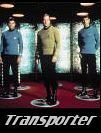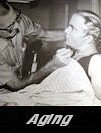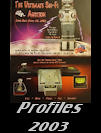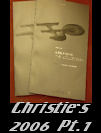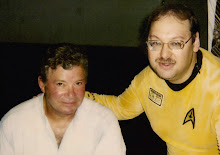While automatic sliding doors are commonplace in today’s shopping malls and supermarkets; this was not the situation when Star Trek: The Original Series first aired on network television – as audiences witnessed the technology aboard the Enterprise respond incredibly quickly and smoothly in anticipation of the crews movements. Herb Solow, Desilu’s Executive In Charge of Production for Star Trek, discusses this aspect of TOS special effects in “Inside Star Trek: The Real Story” (Pocket Books, 1996) …
Superior hand-eye coordination was necessary for brain surgeons, prestidigitators, and the guy responsible for opening the various doors on the set. He accomplished it by standing out of sight of the camera and running the “mechanisms.” The mechanisms consisted of wires attached to the sides of the doors and threaded through a series of pulleys. The assistant director, standing behind camera and watching the scene, would trigger a red light that cued the offstage guy that the moment had arrived for him to open the doors. He would yank on the main wire. This activated the wires running through the pulleys and opened the doors just in time for Kirk or Spock to enter or exit.
The mechanisms always worked; the people responsible weren’t as dependable. Sometimes the cue would be given too early, and the doors would open long before the actors reached them. This “magic door” syndrome usually brought an enthusiastic laugh from everyone except, perhaps, the director, who was usually behind schedule. To him, it wasn’t funny.
Sometimes the cue would be given too late and the actors, trusting souls that they sometimes were, bounced off the unopened doors. This almost always brought an enthusiastic laugh, especially from the director. De Kelley was overheard to remark, “You can get killed walking to the coffee shop aboard this ultra-modern space cruiser.”
Later, when a builder in Santa Barbara, California, wrote to us asking for ideas on how to build sliding doors that work as quickly as those aboard the Enterprise, my recommendation to Bob was to tell the builder to get a different assistant director and a faster offstage guy.

Welcome! As part of its ongoing mission to document the Art and Production History of Star Trek, this site will present technical articles on Star Trek prop and costume authentication - focusing on The Original Series - with detailed photos and episode screenshots to complement the information presented; as well as feature pictorials to showcase Star Trek memorabilia in private & public collections, present rare Behind The Scenes TOS imagery & discuss other topics.
Gerald Gurian is a 40+ year collector of screen used Star Trek memorabilia and a passionate fan of TOS

|
||
| - Star Trek TOS At Auction Part I | - Gurian Collection Highlights | - Greg Jein TOS Hero Type II Phaser |
| -Authenticating a TOS Communicator | -6 Myths About Star Trek Prop Design | -Star Trek 3rd Season Command Tunic |
| - Design Features of TOS Tricorders | -Star Trek Props At National Air & Space | - TOS Leatherette Tricorder |
| - TOS Federation Sciences Dress | -Desilu Studio TOS Prop Fabrication | - Unreleased Allen/Gurian Prop Photos |
| - The Beautiful Women of TOS Part I | -TOS U.S.S. Enterprise 11' Filming Model | - Captain Kirk's Chair from TOS |
| - Spock Ears | -TOS Control Panels & Displays | - Mr. Spock's Science Station |
| - TOS Soundstage at Desilu | -TOS Shatner Romulan Pants | - The Beautiful Women of TOS Pt. II |
| - TOS Galileo Shuttlecraft | -Greg Jein TOS Cage Laser Pistol | - TOS 3rd Season Midgrade Type II Phaser |
| - Dr. McCoy's Sickbay on TOS | -TOS Balok Puppet Head | - Captain Kirk "Mirror, Mirror" Tunic |
| - Greg Jein TOS Hero Tricorder | -1992 Smithsonian TOS Cast Video | - TOS 1st Season Command Tunic |
| - TOS "Where No Man" Silver Contact Lenses | -TOS Special Effects: The Transporter | - The Art of Matt Jefferies |
| - TOS "Space Seed" Gold Mesh Jumpsuit | -Gorn Costume from "Arena" | - Rare TOS Behind-the-Scenes Videos |
| - TOS Stunt Type II Phaser | -1993 Bill Theiss Estate Auction | - TOS Shatner Command Dress Tunic |
| - TOS Elasian Royal Guard Tunic | -TOS Finnegan Silver "Shore Leave" Tunic | - TOS Science Officer Tunic "The Cage" |
| - TOS Shatner Early 1st Season Command Tunic | -William Shatner TOS Tunics At Auction | - TOS Shatner Late 1st Season Command Tunic |
PLEASE NOTE: To see an enlarged version of any photo inside any article, just move your mouse cursor over the image and left-click.
Subscribe to: Posts (Atom)
About Me
Blog Archive
-
▼
2009
(155)
-
▼
January
(12)
- Star Trek X: Nemesis Phaser Rifle
- Star Trek: Voyager Compression Phaser Rifle
- TOS Special Effects: Silver Eyes
- TOS Special Effects: Sliding Doors
- Simulated U.S.S. Enterprise Bridge Update II
- The Star Trek Soundstage at Desilu
- McCoy Uniform Shirt from Star Trek II-IV Feature F...
- Scotty Uniform Shirt from Star Trek II-IV Feature ...
- Dr. McCoy's Sickbay on the Original Series Enterprise
- TOS Costumer Bill Theiss Blue Grecian Style Dress
- TOS Special Effects: The Transporter
- Site Welcomes Over 13,300 Star Trek Fans In 2008
-
▼
January
(12)
|
|
|
THE ORIGINAL SERIES |
|
1st Pilot - The Cage |
|
Landing Party Props |
|
Starfleet |
|
Alien |
|
PHASE II |
|
MODERN SERIES TOS-STYLE |
|
STAR TREK: TNG |
|
STAR TREK: DS9 |
|
STAR TREK: VOYAGER |
|
STAR TREK: ENTERPRISE |
|
STAR TREK: DISCOVERY |
|
STAR TREK: PICARD |
|
STAR TREK FEATURE FILMS |
|
|
|
THE ORIGINAL SERIES |
|
William Shatner |
|
Leonard Nimoy |
|
DeForest Kelley |
|
James Doohan |
|
Nichelle Nichols |
|
Majel Barrett |
|
Starfleet |
|
Star Trek: The Exhibition Main Cast |
|
Aliens |
|
PHASE II |
|
MODERN SERIES TOS-STYLE |
|
STAR TREK: TNG |
|
STAR TREK: DS9 |
|
STAR TREK: VOYAGER |
|
STAR TREK: ENTERPRISE |
|
STAR TREK: DISCOVERY |
|
STAR TREK: PICARD |
|
STAR TREK FEATURE FILMS |
|
|
|
THE ORIGINAL SERIES |
|
STAR TREK: TNG |
|
STAR TREK: DS9 |
|
STAR TREK: VOYAGER |
|
STAR TREK FEATURE FILMS |
|
|
|
THE ORIGINAL SERIES |
|
MODERN SERIES TOS-STYLE |
|
STAR TREK: TNG |
|
STAR TREK: ENTERPRISE |
|
STAR TREK FEATURE FILMS |
|
STAR TREK: THE EXPERIENCE |
|
|
|
TOS HISTORICAL LISTINGS |
|
MAJOR STAR TREK EVENTS |
|
HERITAGE AUCTIONS |
|
THE PROP BLOCK |
|
PROPSTORE |
|
PROFILES IN HISTORY |
|
PROPWORX |
|
SCREENUSED |
|
NOTEWORTHY AUCTIONS |
|
|
|
DOCUMENTS |
|
TOS SPECIAL EFFECTS |
|
RARE TOS VIDEOS |
|
RARE TOS PHOTOS |
|
RAW LINCOLN FILM CLIPS |
|
INSIDE STAR TREK FANZINE |
|
NON-TOS |
|
|
|
THE ORIGINAL SERIES |
|
STAR TREK: TNG |
|
STAR TREK: ENTERPRISE |
|
STAR TREK FEATURE FILMS |
|
NOTEWORTHY VIDEOS |
|
|
|
TO BOLDLY GO BOOKS |
|
SIMULATED BRIDGE |
|
SITE RELATED |
|
WILLIAM SHATNER |
|
LEONARD NIMOY |
|
1992 SMITHSONIAN |
|
ST REBOOT FILMS NEWS |
|
STAR TREK CONVENTIONS |
|
Creation Las Vegas 2010 |
|
Creation Las Vegas 2013 |
|
Creation Las Vegas 2014 |
|
Creation Las Vegas 2015 |
|
THESE ARE THE VOYAGES - TOS |
Star Trek is a Registered Trademark of CBS Studios Inc.
Any material belonging to CBS/Paramount or others Copyrighted Material that may appear on this website complies with fair and/or acceptable use for the purposes of review, study, criticism, or news reporting.
All evaluations and conclusions here are the sole opinion of the author and do not constitute any formal legal declarations. While every effort has been made to post accurate information; it is offered for your reading enjoyment only.
This site uses cookies from Google to deliver its services, to personalize ads and to analyze traffic. Information about your use of this site is shared with Google. By using this site, you agree to its use of cookies. LEARN MORE
This website is not endorsed, sponsored or affiliated with CBS Studios Inc. or the "Star Trek" franchise. The STAR TREK trademarks and logos are owned by CBS Studios Inc.













































